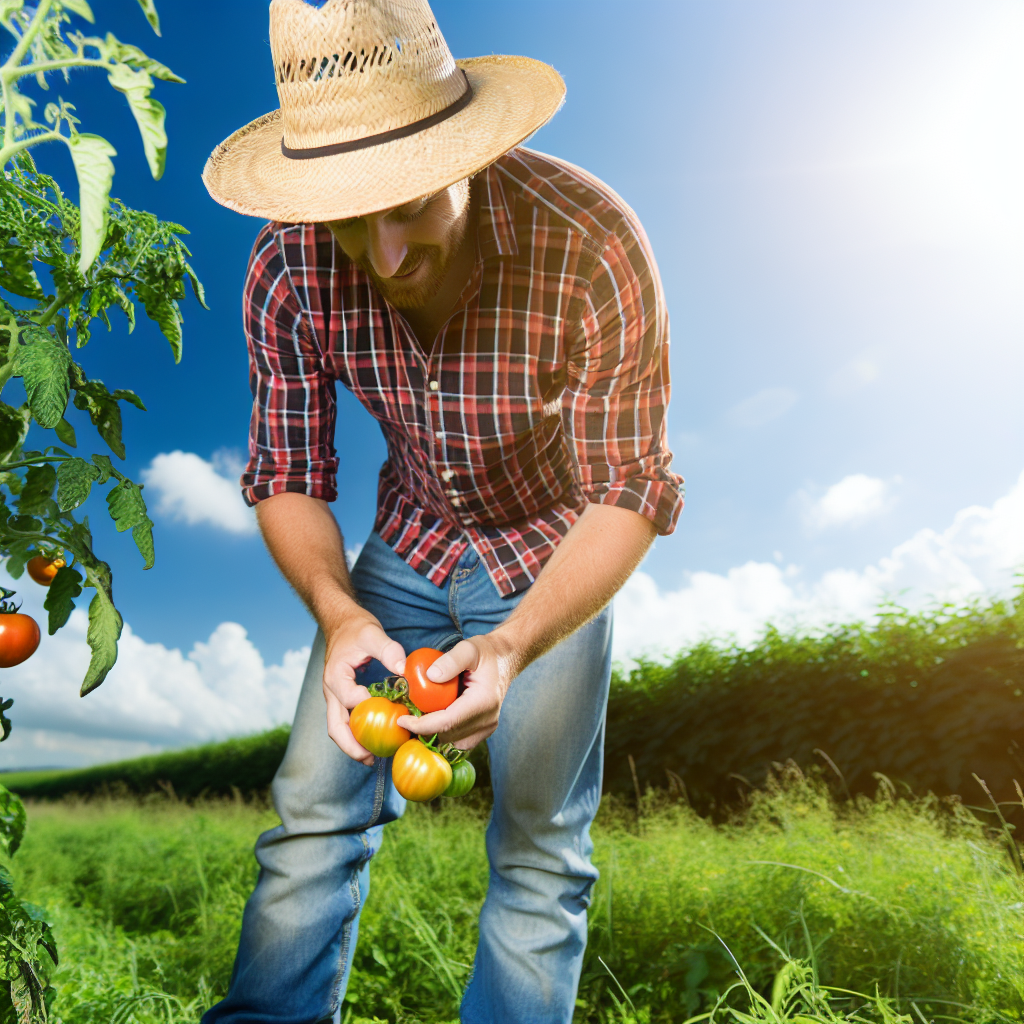Understanding Heirloom Tomatoes
Definition of Heirloom Tomatoes
Heirloom tomatoes are special varieties of tomatoes that are open-pollinated.
These seeds are passed down through generations.
Typically, heirloom tomatoes have a long history that predates modern hybrid varieties.
As a result, they often contain unique flavors and textures.
Historical Context
The history of heirloom tomatoes stretches back to ancient cultures.
For instance, Native Americans cultivated many tomato varieties for their rich flavors.
During the 19th century, gardeners began sharing seeds among communities.
This practice led to the preservation of diverse tomato strains.
The Importance of Heirloom Varieties
Heirloom tomatoes offer exceptional taste and culinary versatility.
They also promote biodiversity within ecosystems.
Furthermore, these tomatoes are often more resilient to local growing conditions.
Farmers and gardeners appreciate heirloom tomatoes for their unique genetics.
Modern Revival
Recently, heirloom tomatoes have gained popularity among organic farmers.
Many chefs endorse heirlooms for their incredible flavors and colors.
This interest has sparked a revival in traditional gardening practices.
Transform Your Agribusiness
Unlock your farm's potential with expert advice tailored to your needs. Get actionable steps that drive real results.
Get StartedConsumers increasingly seek out heirloom varieties at farmers’ markets.
Benefits of Growing Heirloom Tomatoes on Your Farm
Flavor and Quality
Heirloom tomatoes offer unparalleled flavor and quality.
Farmers cherish their diverse taste profiles.
Many consumers prefer heirloom varieties for their rich taste.
Moreover, they generally have fewer chemicals than hybrid types.
Diversity in Varieties
Heirloom tomatoes come in countless shapes, sizes, and colors.
This diversity attracts a wider range of customers.
Some farmers enjoy showcasing unique varieties at local markets.
Additionally, it allows for greater creativity in culinary applications.
Preserving Biodiversity
Growing heirloom tomatoes helps preserve genetic diversity.
These varieties are often open-pollinated and adaptable.
They can thrive in various climates, making them resilient.
Thus, their cultivation supports ecological sustainability.
Market Demand and Premium Pricing
Heirloom tomatoes command higher prices in the market.
Many consumers are willing to pay more for quality produce.
Consequently, farmers can achieve better profit margins.
Moreover, niche markets often seek unique tomato varieties.
Connection to Tradition and History
Heirloom tomatoes carry rich histories and stories.
Farmers can connect consumers with agricultural heritage.
This connection often enhances the value of the product.
Additionally, it fosters a sense of community around local farming.
Key Characteristics to Look for in Heirloom Tomato Varieties
Taste and Flavor
Taste is the hallmark of heirloom tomatoes.
Many varieties offer unique and rich flavors.
Consider personal preferences when selecting types.
Showcase Your Farming Business
Publish your professional farming services profile on our blog for a one-time fee of $200 and reach a dedicated audience of farmers and agribusiness owners.
Publish Your ProfileSome tomatoes provide sweetness, while others may have acidity.
Color and Appearance
The color of heirloom tomatoes varies widely.
Expect shades from deep red to vibrant yellow and green.
Unique markings add visual appeal to many varieties.
Choose a selection based on your aesthetic preferences.
Growth Habit
Different heirloom tomato varieties have distinct growth habits.
Indeterminate types grow tall and require support.
Determinate varieties are bushy and more compact.
Assess your garden space to decide which suits best.
Resistance to Diseases
Look for heirloom varieties with disease resistance.
Common problems include blight and wilt.
Research which heirlooms are hardier in your area.
Maturity Time
Maturity times for heirloom tomatoes differ by variety.
Some may bear fruit in as little as 70 days.
Others require more than 100 days to mature.
Plan your planting for optimal yield schedules.
Seed Saving Potential
Heirloom tomatoes are great for seed saving.
They produce seeds that yield similar plants.
Evaluate your interest in long-term sustainability.
Cultural Significance
Many heirloom varieties have deep cultural stories.
Choosing varieties with historical significance can enrich your garden.
Learn about the heritage of the types you desire.
Discover More: Top Organic Farming Techniques for Beginners
Climate and Soil Requirements for Growing Heirloom Tomatoes
Understanding Climate Needs
Heirloom tomatoes thrive in warm climates.
Achieving a temperature range of 70°F to 85°F is ideal.
They require full sunlight for at least six hours daily.
Excessive humidity can lead to disease.
Therefore, good air circulation is crucial.
Soil Composition
Heirloom tomatoes prefer well-drained, rich soil.
The ideal pH level ranges from 6.0 to 6.8.
Add organic matter to enhance soil structure.
This practice improves moisture retention and nutrient availability.
Sandy loam or loamy soil types work best.
Watering Requirements
Consistent moisture is essential for growth.
Water deeply but infrequently to encourage root depth.
Avoid overhead watering to prevent fungal diseases.
Drip irrigation systems are highly recommended.
Fertilization Practices
Use a balanced fertilizer to support overall health.
Apply fertilizer during planting and after fruit sets.
Organic options include compost and well-rotted manure.
Showcase Your Farming Business
Publish your professional farming services profile on our blog for a one-time fee of $200 and reach a dedicated audience of farmers and agribusiness owners.
Publish Your ProfileTest soil fertility annually to optimize nutrient levels.
Adaptation to Local Conditions
Different heirloom varieties may adapt to local climates.
Choose varieties suited to your specific environment.
Consult with local farmers for region-specific advice.
Research growing seasons to maximize yields.
Explore Further: Maintaining Genetic Diversity Through Seed Saving
Popular Heirloom Tomato Varieties and Their Unique Traits
Brandywine Tomatoes
Brandywine tomatoes are beloved for their rich flavor.
They produce large, pinkish-red fruits that are often lopsided.
Additionally, they thrive in various climates, making them widely adaptable.
Black Krim Tomatoes
Black Krim tomatoes feature a deep maroon color with green shoulders.
These tomatoes are known for their slightly salty taste.
They perform well in warmer temperatures, enhancing their flavor.
Green Zebra Tomatoes
Green Zebra tomatoes stand out with their striking green and yellow stripes.
Their tangy flavor complements salads and salsas perfectly.
These tomatoes grow well in various soils and conditions.
Mortgage Lifter Tomatoes
Mortgage Lifter tomatoes are large with a sweet, juicy interior.
They were bred to help farmers pay off debts, hence the name.
These tomatoes are very productive, yielding consistently across seasons.
San Marzano Tomatoes
San Marzano tomatoes are renowned for their rich flavor and low acidity.
They are the preferred choice for making sauces and pastes.
These tomatoes thrive in well-drained soils and require plenty of sunlight.
Thessaloniki Tomatoes
Thessaloniki tomatoes deliver a deliciously balanced flavor profile.
They are perfect for fresh eating or cooking due to their firm flesh.
This variety is resilient and grows well in many growing zones.
Yellow Pear Tomatoes
Yellow Pear tomatoes are small, pear-shaped fruits with a bright yellow hue.
They are sweet, making them ideal for snacking and salads.
Additionally, they are easy to grow, making them perfect for beginners.
Find Out More: Essential Tools for Successful Organic Gardens

How to Select Seeds: Sourcing and Certification for Heirloom Varieties
Understanding Heirloom Tomato Varieties
Heirloom tomatoes are known for their rich flavors.
These varieties have historical significance and diverse genetics.
Sourcing heirloom seeds can enhance your farm’s biodiversity.
Identifying Reputable Seed Sources
Start by researching established seed companies.
Choose those specializing in heirloom varieties.
Seek recommendations from local farmers or garden clubs.
Additionally, check for online reviews and ratings.
Some recommended sources include Seed Savers Exchange and Baker Creek Heirloom Seeds.
Certifying Seed Quality
Quality assurance is crucial when selecting heirloom seeds.
Look for seeds that come with organic or non-GMO certifications.
This ensures you are purchasing reliable seeds.
Additionally, verify if the seeds are tested for germination rates.
Showcase Your Farming Business
Publish your professional farming services profile on our blog for a one-time fee of $200 and reach a dedicated audience of farmers and agribusiness owners.
Publish Your ProfileA higher germination rate indicates healthier seeds.
Assessing Seed Adaptability
Different heirloom varieties thrive in various climates.
Research the specific climate conditions of your farm.
Choose varieties that have demonstrated success in similar environments.
By understanding your local growing conditions, you can make informed decisions.
Engaging with Heirloom Seed Communities
Join local agricultural groups or online forums focused on heirloom seeds.
These communities often share valuable resources and tips.
Participating in seed swaps can expand your selection.
You can connect with other farmers who share the same passion.
Documenting Seed Varieties
Keep records of the seeds you select for planting.
Document their growth patterns and yield results.
This information helps in evaluating their performance annually.
You can later modify your selections based on this data.
Find Out More: Urban Farming Success Stories To Inspire
Pest and Disease Management for Heirloom Tomato Farming
Importance of Pest and Disease Management
Pest and disease management is crucial in heirloom tomato farming.
It helps protect the plants and ensures a healthy yield.
Effective management practices reduce crop losses significantly.
Common Pests Affecting Heirloom Tomatoes
Various pests target heirloom tomatoes throughout the growing season.
- Aphids are tiny but can multiply quickly on plants.
- Spider mites thrive in hot, dry conditions and damage leaves.
- Whiteflies spread viruses and weaken plants by sucking sap.
- Hornworms can consume leaves rapidly if left unchecked.
Disease Risks and Symptoms
Diseases can severely impact heirloom tomato crops.
Fungal diseases like blight often present with dark spots on leaves.
Bacterial wilt causes wilting and yellowing of foliage.
Viruses can lead to mottled leaves and stunted growth.
Integrated Pest Management Strategies
Employing integrated pest management (IPM) is beneficial.
Start by monitoring pest populations regularly and systematically.
Encourage beneficial insects like ladybugs to control aphids.
Use physical barriers such as row covers to deter pests.
Rotate crops to disrupt pest life cycles and reduce disease risk.
Cultural Practices for Disease Prevention
Implement cultural practices to promote plant health.
Ensure proper spacing for air circulation among plants.
Water tomatoes at the base to avoid wet foliage.
Remove diseased plants to prevent spread and reinfection.
Utilize disease-resistant heirloom varieties whenever possible.
Organic Control Methods
Organic control methods also offer effective solutions.
Insecticidal soaps eliminate soft-bodied pests on contact.
Neem oil serves as both an insecticide and fungicide.
Introduce companion planting to naturally repel harmful insects.
Best Practices for Harvesting and Storing Heirloom Tomatoes
Harvesting Heirloom Tomatoes
Carefully observe the color of heirloom tomatoes before harvesting.
Look for deep hues indicative of ripeness.
Softness also signals that a tomato is ready to pick.
Gently twist the fruit from the vine to avoid damage.
Showcase Your Farming Business
Publish your professional farming services profile on our blog for a one-time fee of $200 and reach a dedicated audience of farmers and agribusiness owners.
Publish Your ProfileUse clean, sharp pruning shears for cutting if necessary.
Timing for Harvesting
Early morning is the ideal time for harvesting tomatoes.
This time minimizes stress on the plant.
Harvesting before the heat of the day preserves freshness.
Storage Techniques
Store harvested tomatoes at room temperature.
Avoid refrigeration unless tomatoes are overripe.
Refrigeration can alter flavor and texture negatively.
Assessing Tomato Quality for Storage
Inspect each tomato for flaws before storing.
Reject any that exhibit signs of rot or bruising.
Check for blemishes as they can lead to spoilage.
Handling Heirloom Tomatoes
Handle tomatoes with care to avoid bruising.
Use padded containers to minimize impact during transport.
Consider using a single layer for short-term storage.
Maintaining Flavor and Freshness
Keep tomatoes away from direct sunlight during storage.
Monitor stored tomatoes regularly for any signs of spoilage.
Use any overripe tomatoes promptly in recipes.
Long-Term Storage Options
Canning and freezing are effective methods for long-term storage.
Blanch tomatoes briefly before freezing them for better texture.
Ensure jars are clean and sterilized for canning purposes.
Additional Resources
How Do Tomatoes Get Their Price
Farmer Annie – Page 2 – Dark Wood Farm




